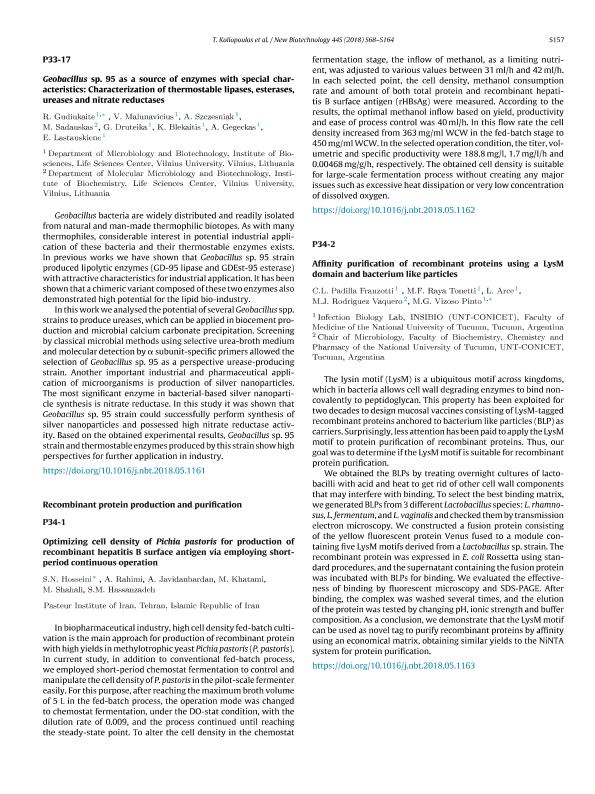Mostrar el registro sencillo del ítem
dc.contributor.author
Padilla Franzotti, Carla Luciana

dc.contributor.author
Raya Tonetti, María Fernanda

dc.contributor.author
Arce, Lorena Paola

dc.contributor.author
Rodriguez Vaquero, Maria Jose

dc.contributor.author
Vizoso Pinto, María Guadalupe

dc.date.available
2019-08-09T18:34:00Z
dc.date.issued
2018-08
dc.identifier.citation
Padilla Franzotti, Carla Luciana; Raya Tonetti, María Fernanda; Arce, Lorena Paola; Rodriguez Vaquero, Maria Jose; Vizoso Pinto, María Guadalupe; Affinity purification of recombinant proteins using a LysM domain and bacterium like particles; Elsevier Science; New Biotechnology; 44; 8-2018; 157-157
dc.identifier.issn
1871-6784
dc.identifier.uri
http://hdl.handle.net/11336/81334
dc.description.abstract
The lysin motif (LysM) is a ubiquitous motif across kingdoms, which in bacteria allows cell wall degrading enzymes to bind noncovalently to peptidoglycan. This property has been exploited for two decades to design mucosal vaccines consisting of LysM-tagged recombinant proteins anchored to bacterium like particles (BLP) as carriers. Surprisingly, less attention has been paid to apply the LysM motif to protein purification of recombinant proteins. Thus, our goal was to determine if the LysM motif is suitable for recombinant protein purification.We obtained the BLPs by treating overnight cultures of lactobacilli with acid and heat to get rid of other cell wall components that may interfere with binding. To select the best binding matrix, we generated BLPs from 3 different Lactobacillus species: L. rhamnosus, L. fermentum, and L. vaginalis and checked them by transmission electron microscopy. We constructed a fusion protein consisting of the yellow fluorescent protein Venus fused to a module containing five LysM motifs derived from a Lactobacillus sp. strain. The recombinant protein was expressed in E. coli Rossetta using standard procedures, and the supernatant containing the fusion protein was incubated with BLPs for binding. We evaluated the effectiveness of binding by fluorescent microscopy and SDS-PAGE. After binding, the complex was washed several times, and the elution of the protein was tested by changing pH, ionic strength and buffer composition. As a conclusion, we demonstrate that the LysM motif can be used as novel tag to purify recombinant proteins by affinity using an economical matrix, obtaining similar yields to the NiNTA system for protein purification.
dc.format
application/pdf
dc.language.iso
eng
dc.publisher
Elsevier Science

dc.rights
info:eu-repo/semantics/openAccess
dc.rights.uri
https://creativecommons.org/licenses/by-nc-sa/2.5/ar/
dc.subject
Recombinant Proteins
dc.subject
Lactobacillus Species
dc.subject.classification
Biología Celular, Microbiología

dc.subject.classification
Ciencias Biológicas

dc.subject.classification
CIENCIAS NATURALES Y EXACTAS

dc.title
Affinity purification of recombinant proteins using a LysM domain and bacterium like particles
dc.type
info:eu-repo/semantics/article
dc.type
info:ar-repo/semantics/artículo
dc.type
info:eu-repo/semantics/publishedVersion
dc.date.updated
2019-08-06T18:13:40Z
dc.journal.volume
44
dc.journal.pagination
157-157
dc.journal.pais
Países Bajos

dc.journal.ciudad
Amsterdam
dc.description.fil
Fil: Padilla Franzotti, Carla Luciana. Universidad Nacional de Tucumán. Facultad de Medicina; Argentina. Consejo Nacional de Investigaciones Científicas y Técnicas. Centro Científico Tecnológico Conicet - Tucumán. Instituto Superior de Investigaciones Biológicas. Universidad Nacional de Tucumán. Instituto Superior de Investigaciones Biológicas; Argentina
dc.description.fil
Fil: Raya Tonetti, María Fernanda. Universidad Nacional de Tucumán. Facultad de Medicina; Argentina. Consejo Nacional de Investigaciones Científicas y Técnicas. Centro Científico Tecnológico Conicet - Tucumán. Instituto Superior de Investigaciones Biológicas. Universidad Nacional de Tucumán. Instituto Superior de Investigaciones Biológicas; Argentina
dc.description.fil
Fil: Arce, Lorena Paola. Universidad Nacional de Tucumán. Facultad de Medicina; Argentina. Consejo Nacional de Investigaciones Científicas y Técnicas. Centro Científico Tecnológico Conicet - Tucumán. Instituto Superior de Investigaciones Biológicas. Universidad Nacional de Tucumán. Instituto Superior de Investigaciones Biológicas; Argentina
dc.description.fil
Fil: Rodriguez Vaquero, Maria Jose. Universidad Nacional de Tucuman. Facultad de Bioquímica, Química y Farmacia. Instituto de Microbiología "luis Verna". Cátedra de Microbiología Gral.; Argentina. Consejo Nacional de Investigaciones Científicas y Técnicas. Centro Científico Tecnológico Conicet - Tucumán; Argentina
dc.description.fil
Fil: Vizoso Pinto, María Guadalupe. Universidad Nacional de Tucumán. Facultad de Medicina; Argentina. Consejo Nacional de Investigaciones Científicas y Técnicas. Centro Científico Tecnológico Conicet - Tucumán. Instituto Superior de Investigaciones Biológicas. Universidad Nacional de Tucumán. Instituto Superior de Investigaciones Biológicas; Argentina
dc.journal.title
New Biotechnology

dc.relation.alternativeid
info:eu-repo/semantics/altIdentifier/url/https://www.sciencedirect.com/science/article/pii/S1871678418314833?via%3Dihub
dc.relation.alternativeid
info:eu-repo/semantics/altIdentifier/url/https://doi.org/10.1016/j.nbt.2018.05.1163
Archivos asociados
